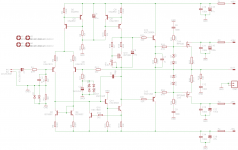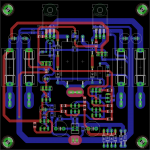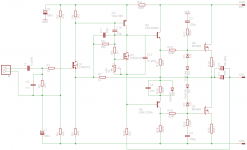Well, yes, insofar as I've never seen Douglas Self design featuring a MOSFET output stage. But the front-end is textbook Blameless. The Vgs multiplier took a little working out.
I'm hoping to prove the basic design and then MkIII will add Cordell's EC circuitry, and I will finish what I started earlier: http://www.diyaudio.com/forums/solid-state/261935-simple-inexpensive-hexfet-amp-ec.html
But the printed circuit layout is not too bad, is it?
I'm hoping to prove the basic design and then MkIII will add Cordell's EC circuitry, and I will finish what I started earlier: http://www.diyaudio.com/forums/solid-state/261935-simple-inexpensive-hexfet-amp-ec.html
But the printed circuit layout is not too bad, is it?
MosZilla
Hugh, here's another one I cooked up this evening; you might find this more interesting.
I've got a bag full of IRF840s leftover from another project, and I thought it might be interesting to try another quasi design, this time with an all-MOSFET output stage, AC coupled.
Originally I thought to try a JFET input transistor since they are more linear than un-degenerated bipolars, but then I stumbled across the ZVN3310, while browsing the FetZilla thread. It was originally mooted as the VAS device for that design, but it seems to me it would do better as an input transistor. VAS remains my favorite KSA1381.
Need to think more about biasing.
Hugh, here's another one I cooked up this evening; you might find this more interesting.
I've got a bag full of IRF840s leftover from another project, and I thought it might be interesting to try another quasi design, this time with an all-MOSFET output stage, AC coupled.
Originally I thought to try a JFET input transistor since they are more linear than un-degenerated bipolars, but then I stumbled across the ZVN3310, while browsing the FetZilla thread. It was originally mooted as the VAS device for that design, but it seems to me it would do better as an input transistor. VAS remains my favorite KSA1381.
Need to think more about biasing.
Attachments
Hi Christian,
Nice circuit; BUT, you'd need a DC blocking cap on R6. Thermal control of bias, devolved to Q3 and Q7, might be tetchy (as you say); the Vgs multiplier might need a bit less compensation, but it would be close. The other fine details are very good; I notice you have set global feedback at 38.3dB (82), and the use of the mosfet ZVP for the input is brilliant.
Sakis asks about the sound of the output devices; not sure about that device. Since the Fairchild FQA series are cheaper than the Vishays and higher transconductance I'd try them, and they also have lower rds on; my experiences indicate the sound quality is just as good as the 5200/1943s, which I have used for years and are related to the 1302/3281 series.
This circuit would not have huge resolution, exhibit highish H2 and H3 but it would be intensely musical. A lot of people love quasis, particularly in the PA industry - easy and cheap to fix, and high levels of H2.
Good design!
Hugh
Nice circuit; BUT, you'd need a DC blocking cap on R6. Thermal control of bias, devolved to Q3 and Q7, might be tetchy (as you say); the Vgs multiplier might need a bit less compensation, but it would be close. The other fine details are very good; I notice you have set global feedback at 38.3dB (82), and the use of the mosfet ZVP for the input is brilliant.
Sakis asks about the sound of the output devices; not sure about that device. Since the Fairchild FQA series are cheaper than the Vishays and higher transconductance I'd try them, and they also have lower rds on; my experiences indicate the sound quality is just as good as the 5200/1943s, which I have used for years and are related to the 1302/3281 series.
This circuit would not have huge resolution, exhibit highish H2 and H3 but it would be intensely musical. A lot of people love quasis, particularly in the PA industry - easy and cheap to fix, and high levels of H2.
Good design!
Hugh
Last edited:
Hi
I wonder if the enhancement mosfet is the best input device? I suspect a cascoded J-fet might be better, noise wise anyway. Bias the J-fet source with a CCS from the negative rail.
It might be interesting to make two versions so as to compare BJTs and Mosfets. Is there any particular reason you want to use quasi comp output stage instead of complementary?
Fairchild FQA series mosfets are planer stripe fets not hexfets. They are DMOS, first generation type mosfets but with minor differences in die architecture and properties to hexfet devices. Gm tends to be more affected by Vds than in hexfet devices and tends to droop significantly at low Id, class AB bias. (Not to say that hexfets do not droop in Gm at low currents, they do. ) Planer stripe fets seem to be really physically tough when driving them hard. Although I have not used these devices in class AB without some sort of local error correction, I suspect the overall behavior would not be that much different than traditional hexfet devices. Without EC and used in this way, bias should be at least greater than 100mA, closer to 200mA would keep the load line a little further away from the Gm droop region. BTW, FQP is the TO-220 version of these transistors. If the number is the same then the FQP is the same die as the FQA but just in a smaller package. There is also the FQU series that are in a I-pak, a bit smaller than TO-220.
) Planer stripe fets seem to be really physically tough when driving them hard. Although I have not used these devices in class AB without some sort of local error correction, I suspect the overall behavior would not be that much different than traditional hexfet devices. Without EC and used in this way, bias should be at least greater than 100mA, closer to 200mA would keep the load line a little further away from the Gm droop region. BTW, FQP is the TO-220 version of these transistors. If the number is the same then the FQP is the same die as the FQA but just in a smaller package. There is also the FQU series that are in a I-pak, a bit smaller than TO-220.
I wonder if the enhancement mosfet is the best input device? I suspect a cascoded J-fet might be better, noise wise anyway. Bias the J-fet source with a CCS from the negative rail.
It might be interesting to make two versions so as to compare BJTs and Mosfets. Is there any particular reason you want to use quasi comp output stage instead of complementary?
Fairchild FQA series mosfets are planer stripe fets not hexfets. They are DMOS, first generation type mosfets but with minor differences in die architecture and properties to hexfet devices. Gm tends to be more affected by Vds than in hexfet devices and tends to droop significantly at low Id, class AB bias. (Not to say that hexfets do not droop in Gm at low currents, they do.
Thanks Hugh, I drew this late last night and forgot the NFB shunt cap... oops...
Yes the loop gain is low, in keeping with the FetZilla design philosophy. The IRF840 outputs I spec'd are small TO-220 devices, and my plan was to set the rail voltage very low (50V) and bias them HOT (say >500mA) reducing output distortion and hopefully getting by with very little NFB. Overall Pd would still be manageable in the hot Australian summer...
But you have me interested in the big Fairchild FQA series in the TO-3P packages. The circuit here has good strong gate drive ability. Looking at the Fairchild datasheets the FQA32N20 seems to be the pick of the bunch with an enormous 32A drain current and a not unmanageable 1.7nF Ciss. I believe you have played with its close relation, the FQA40N25, which has slightly higher Id and 3.3nF Ciss.
I would be tempted to redesign this with a pair of FQA32N20's running from a 100V rail, ~150mA standing current and compensate by adding a VAS follower to increase loop gain. I'd love to hear other ideas that don't involve adding a bunch of active parts to the circuit.
CBS, I recently built my first quasi amplifier a short while ago, with a lot of input from experts including Hugh, Richard and others. It sounds very, very good indeed. Actually it sounds terrific. Not at all what I expected from such an "antiquated" design. Further details here if interested:
http://www.diyaudio.com/forums/soli...ple-quasi-complimentary-mosfet-amplifier.html
It features a singleton bipolar input, and myself and one other builder noticed some minor issues with DC bias stability. I don't consider a +/-100mV DC drift particularly problematic, however many would disagree. The best solutions are to either servo it or AC couple the output. I thought I'd take the latter option since its an interesting new avenue to explore.
I will definitely come back to my "blameless" and EC projects, if only to annoy Hugh ;-)
Yes the loop gain is low, in keeping with the FetZilla design philosophy. The IRF840 outputs I spec'd are small TO-220 devices, and my plan was to set the rail voltage very low (50V) and bias them HOT (say >500mA) reducing output distortion and hopefully getting by with very little NFB. Overall Pd would still be manageable in the hot Australian summer...
But you have me interested in the big Fairchild FQA series in the TO-3P packages. The circuit here has good strong gate drive ability. Looking at the Fairchild datasheets the FQA32N20 seems to be the pick of the bunch with an enormous 32A drain current and a not unmanageable 1.7nF Ciss. I believe you have played with its close relation, the FQA40N25, which has slightly higher Id and 3.3nF Ciss.
I would be tempted to redesign this with a pair of FQA32N20's running from a 100V rail, ~150mA standing current and compensate by adding a VAS follower to increase loop gain. I'd love to hear other ideas that don't involve adding a bunch of active parts to the circuit.
CBS, I recently built my first quasi amplifier a short while ago, with a lot of input from experts including Hugh, Richard and others. It sounds very, very good indeed. Actually it sounds terrific. Not at all what I expected from such an "antiquated" design. Further details here if interested:
http://www.diyaudio.com/forums/soli...ple-quasi-complimentary-mosfet-amplifier.html
It features a singleton bipolar input, and myself and one other builder noticed some minor issues with DC bias stability. I don't consider a +/-100mV DC drift particularly problematic, however many would disagree. The best solutions are to either servo it or AC couple the output. I thought I'd take the latter option since its an interesting new avenue to explore.
I will definitely come back to my "blameless" and EC projects, if only to annoy Hugh ;-)
- Status
- This old topic is closed. If you want to reopen this topic, contact a moderator using the "Report Post" button.
- Home
- Amplifiers
- Solid State
- CSH4 MkII HEXFET amplifier


